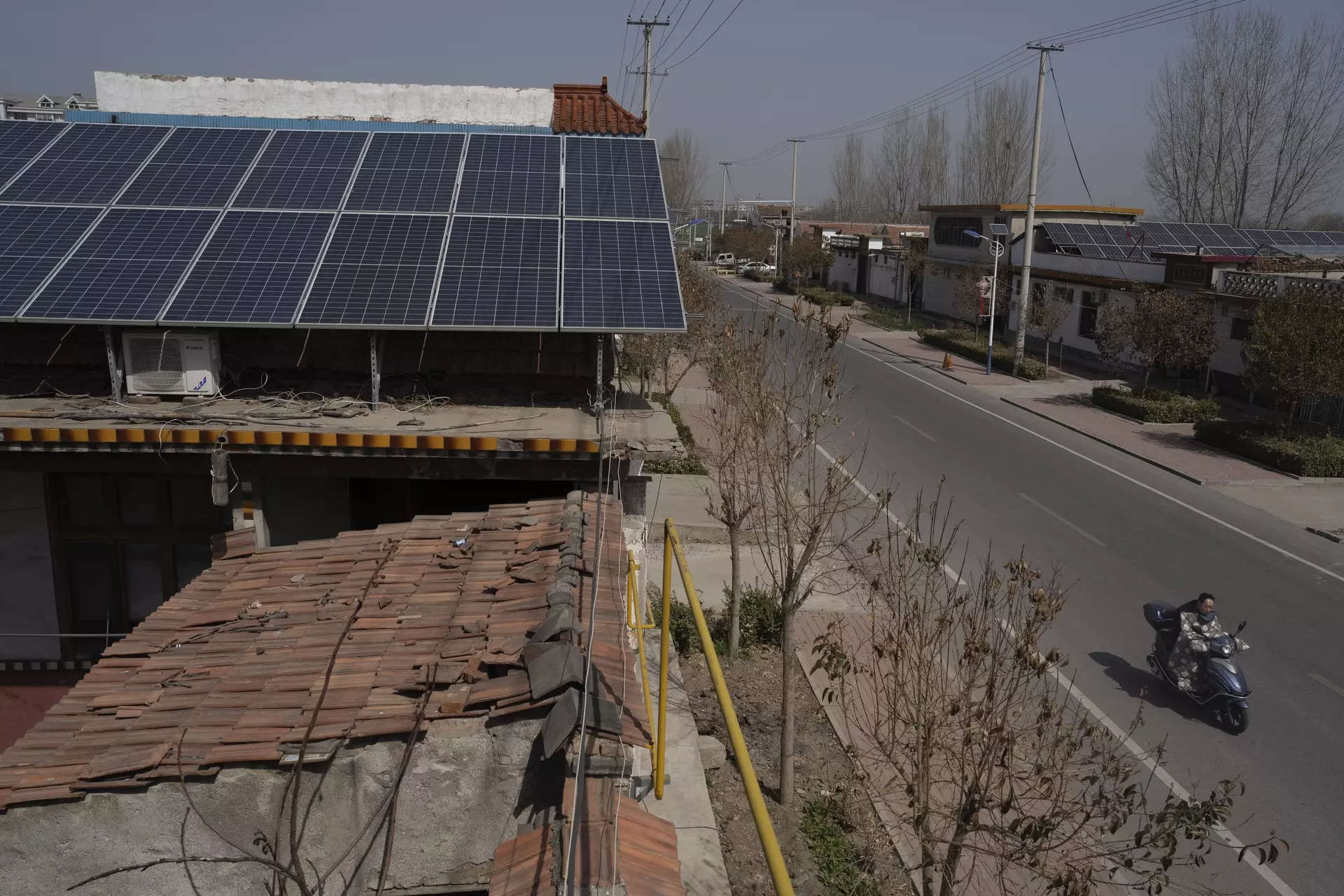- Renewable 可再生
- 4 min read
Why are Chinese electric cars in EU crosshairs?
為什麼中國電動汽車成為歐盟的焦點?
Here's why the Chinese electric vehicle market has raised hackles among European policymakers -- and what impact the move could have.這就是為什麼中國電動車市場引起歐洲政策制定者的不滿,以及這一舉措可能產生的影響。

北京:歐盟將於星期五對中國電動汽車徵收高達 38%的額外臨時關稅,因為歐盟認為中國製造商受惠於不公平的國家支持。
Here's why the Chinese electric vehicle market has raised hackles among European policymakers -- and what impact the move could have:
這就是為什麼中國電動車市場引起歐洲政策制定者的不滿,以及這一舉措可能產生的影響:
- How did China's EV sector get so strong? -
中國的電動車行業是如何變得如此強大的?
China has spearheaded a targeted industrial strategy to boost its EV sector, pouring vast state funds into domestic firms as well as research and development.
中國一直在帶頭推動有針對性的工業戰略,以促進其電動車行業,將大量國家資金投入國內企業以及研究和開發。
Between 2014 and the end of 2022, the Chinese government said it had spent more than 200 billion yuan ($28 billion) on subsidies and tax breaks for EV purchases alone.
2014 年至 2022 年底,中國政府表示單單在電動車購買上已花費超過 2000 億元(280 億美元)的補貼和減稅。
The approach has given Chinese firms a critical edge in the race to provide cheaper, more efficient EVs over leading European automakers, which have not always enjoyed such state largesse.
這種方法讓中國企業在提供更便宜、更高效的電動車方面取得了關鍵優勢,超越了歐洲領先的汽車製造商,這些製造商並不總是享受到這種國家的慷慨。
They have also been boosted by surging domestic demand: Of all new EVs sold globally in December last year, 69 percent were in China, according to the research firm Rystad Energy.
他們還受到國內需求激增的推動:根據研究公司 Rystad Energy 的數據,去年十二月全球新銷售的電動車中,有 69%在中國。
Exports are soaring. According to the Atlantic Council, Chinese sales of EVs abroad rose 70 percent in 2023, reaching $34.1 billion.
出口量飆升。根據大西洋理事會的報告,2023 年中國對外銷售的電動車增長了 70%,達到 341 億美元。
Almost 40 percent went to the European Union, the largest recipient of Chinese EVs.
近 40%的中國電動車出口到歐盟,是中國電動車的最大出口目的地。
The EU market share of Chinese-made EVs climbed from around three percent to more than 20 percent in the past three years, according to the European Automobile Manufacturers' Association.
中國製造的電動汽車在過去三年中的歐盟市場份額從約 3%上升至超過 20%,根據歐洲汽車製造商協會。
continued below
- 關鍵人物是誰? -
The overwhelming market leader from China is BYD, which this year posted record annual profits for 2023 and says it aims to be among the top five car companies in Europe.
中國壟斷市場的領導者是比亞迪(BYD),今年實現了 2023 年的歷史性年度利潤,並表示其目標是成為歐洲前五大汽車公司之一。
Last year, it became the first manufacturer to pass the five million milestone in terms of hybrids and all-electric vehicles produced, cumulatively -- crowning itself as "the world's leading manufacturer of new energy vehicles".
去年,它成為第一家在混合動力和全電動車生產方面突破五百萬里程碑的製造商,累計生產量 -- 成為“全球領先的新能源汽車製造商”。
Among the other top Chinese EV makers exporting to Europe are SAIC, MG Motor and Polestar -- owned by Volvo and its Chinese parent firm Geely -- according to state media.
根據官方媒體報導,另外一些主要的中國電動車製造商出口到歐洲的有上汽、MG 汽車和極星,極星是富豪和其中國母公司吉利旗下的品牌。
- Why is the EU worried? -
- 歐盟為什麼擔心? -
The surge in exports has allowed Chinese firms to rapidly increase their share of the EU market for EVs.
出口激增使中國企業迅速增加了在歐盟電動車市場的佔有率。
The EU has now concluded that Chinese manufacturers benefited from "unfair subsidisation, which is causing a threat of economic injury" to European automakers.
歐盟現在得出結論,中國製造商受益於「不公平補貼,對歐洲汽車製造商構成經濟損害威脅」。
But there is also dissent within the EU -- Germany, a major trade partner whose car market is heavily reliant on China, warned tariffs would harm German companies.
但歐盟內部也存在分歧——德國是一個重要的貿易夥伴,其汽車市場高度依賴中國,警告關稅將損害德國公司。
The EU will now impose provisional duties between 20 and 38 percent on top of the current 10 percent tariff on Chinese electric cars.
歐盟現在將對中國電動汽車目前的 10%關稅徵收 20%至 38%的臨時關稅。
Definitive duties will take effect in November for a period of five years, pending a vote by the EU's 27 states.
明確的關稅將於 11 月生效,為期五年,待歐盟 27 個成員國投票通過。
- How has Beijing reacted? -
北京做出了什麼反應?
Beijing has yet to react but a Chinese trade group condemned the bloc's "protectionism".
北京尚未做出反應,但一個中國貿易團體譴責了該集團的「保護主義」。
China has already bared its teeth however, kickstarting an anti-dumping investigation into pork imports from the EU, threatening Spanish exports.
中國已經展開了反傾銷調查,對來自歐盟的豬肉進口發起調查,威脅西班牙出口。
In January, China launched an anti-dumping investigation into brandy imported from the EU, in a move seen as targeting France, which had pushed for the commission's probe.
今年一月,中國對從歐盟進口的白蘭地發起了一項反傾銷調查,這被視為針對法國的舉措,法國一直在推動歐盟委員會的調查。
Beijing said in June it "reserves the right" to file a case with the World Trade Organization over the EU tariffs.
北京在六月表示,對歐盟關稅保留提起世界貿易組織案件的權利。
- How have car manufacturers reacted? -
汽車製造商作出了怎樣的反應?
Since the EU's move will impact all Chinese-made electric cars, Tesla's Model 3, the electric Mini, and the Volvo EX40 are also among the vehicles that will face higher duties.
由於歐盟的舉措將影響所有中國製造的電動汽車,特斯拉的 Model 3、電動 Mini 和沃爾沃 EX40 也將面臨更高的關稅。
A Tesla spokesperson said prices for the Model 3 -- the number three in electric car sales in Europe -- should increase "in the short term".
特斯拉發言人表示,歐洲電動車銷售排名第三的 Model 3 價格應該會在短期內上漲。
China's electric car makers Nio and XPeng told AFP they had no plans to quit the European market after the announcement.
中國的電動車製造商蔚來和小騎士告訴法新社,他們沒有計劃退出歐洲市場。
Meanwhile, MG France said it already imported 2,600 electric vehicles from China that have cleared customs.
與此同時,MG 法國表示已從中國進口了 2600 輛已通過海關的電動車。
- What impact will the tariffs have? -
- 關稅將會有什麼影響? -
Germany's Kiel Institute for the World Economy, alongside Austrian institutes, predicted the higher taxes will reduce vehicle imports from China by 42 percent.
德國基爾世界經濟研究所與奧地利研究機構預測,更高的稅收將使中國汽車進口減少 42%。
Electric car prices could rise by an average of 0.3 to 0.9 percent in the EU, they added.
電動車價格可能在歐盟上漲平均 0.3 至 0.9%。
Cui Dongshu, secretary-general of the China Passenger Car Association, said costs for Chinese exporters of EVs and EU consumers would increase, and the duties would also hit the bloc's energy conservation and green development goals.
中國乘用車協會秘書長崔東樹表示,對中國電動車出口商和歐盟消費者來說,成本將增加,關稅也將影響該區域的節能和綠色發展目標。
















COMMENTS
All Comments
By commenting, you agree to the Prohibited Content Policy
PostBy commenting, you agree to the Prohibited Content Policy
Post